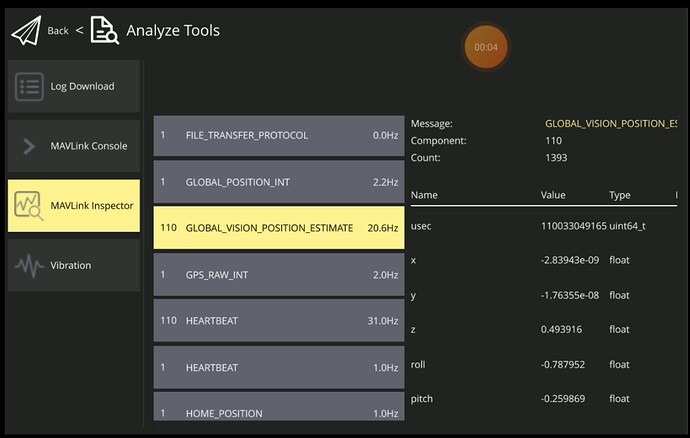I see from the doc that GLOBAL_VISION_POSITION_ESTIMATE is not recommended, but this is the only one that has given me some actual results; I tested VISION_POSITION_ESTIMATE, ODOMETRY. When I send an odometry message (using mavlink_msg_odometry_encode), the message does not even appear in Mavlink Inspector.
Actually, I attempted to provide vision coordinate many times (at least 4 serious attempts). No success each time, so ended up using set attitude target and solved the task up to some degree (optical stab on any height, tested up to 1km). But I don’t like this solution, I want more consistent integration.
Build settings:
{“selected_features”: [“AHRS_EXT”, “AHRS_EXT_VECTORNAV”, “BARO_WIND_COMP”, “EKF3”, “EKF3_EXTNAV”, “EKF3_OPTFLOW”, “EKF3_WINDEST”, “VISUALODOM”, “BARO_TEMPCAL”, “MSP_BARO”, “SPL06”, “BATTERY_SUM”, “Camera”, “Camera_Relay”, “Camera_Servo”, “RUNCAM”, “AK09916”, “BMM150”, “BMM350”, “CompassLearn”, “FixedYawCal”, “HMC5843”, “ICM20948”, “IST8308”, “IST8310”, “LIS3MDL”, “MMC3416”, “QMC5883L”, “RM3100”, “MODE_BRAKE”, “MODE_FLIP”, “MODE_GUIDED_NOGPS”, “MODE_TURTLE”, “FILESYSTEM_MISSION”, “FILESYSTEM_PARAM”, “FILESYSTEM_ROMFS”, “FILESYSTEM_SYS”, “NMEA_GPS”, “NMEA_UNICORE”, “UBLOX”, “BatchSampler”, “HarmonicNotches”, “AP_MAVLINK_FTP_ENABLED”, “FENCEPOINT_PROTOCOL”, “MAVLINK_MSG_MISSION_REQUEST”, “MAVLINK_MSG_RC_CHANNELS_RAW”, “MAV_DEVICE_OP”, “MAV_MSG_SERIAL_CONTROL”, “MAV_SERVO_RELAY”, “RALLYPOINT_PROTOCOL”, “REQUEST_AUTOPILOT_CAPA”, “MSP”, “MSP_COMPASS”, “MSP_DISPLAYPORT”, “MSP_GPS”, “MSP_RANGEFINDER”, “LED_CONTROL”, “NOTIFY_NEOPIXEL”, “NOTIFY_PROFILED”, “PLAY_TUNE”, “TONEALARM”, “OSD”, “OSD_PARAM”, “OSD_SIDEBARS”, “Buttons”, “COMPASS_CAL”, “CUSTOM_ROTATIONS”, “Logging”, “SDCARD_FORMATTING”, “LANDING_GEAR”, “RELAY”, “SERVORELAY_EVENTS”, “RC_CRSF”, “RC_GHST”, “RC_IBUS”, “RC_PPMSUM”, “RC_Protocol”, “RC_SBUS”, “RC_SRXL”, “RC_SRXL2”, “RC_ST24”, “RC_SUMD”, “RSSI”, “RANGEFINDER”, “RANGEFINDER_ANALOG”, “RANGEFINDER_BENEWAKE_TF02”, “RANGEFINDER_BENEWAKE_TF03”, “RANGEFINDER_BLPING”, “RANGEFINDER_GYUS42V2”, “RANGEFINDER_HC_SR04”, “RANGEFINDER_LANBAO”, “RANGEFINDER_LEDDARONE”, “RANGEFINDER_LEDDARVU8”, “RANGEFINDER_LIGHTWARE_SERIAL”, “RANGEFINDER_LWI2C”, “RANGEFINDER_MAVLINK”, “RANGEFINDER_MAXBOTIX_SERIAL”, “RANGEFINDER_MAXSONARI2CXL”, “RANGEFINDER_NMEA”, “RANGEFINDER_PULSEDLIGHTLRF”, “RANGEFINDER_PWM”, “RANGEFINDER_TRI2C”, “RANGEFINDER_TR_SERIAL”, “RANGEFINDER_USD1_SERIAL”, “RANGEFINDER_VL53L0X”, “RANGEFINDER_VL53L1X”, “RANGEFINDER_WASP”, “RFND_BENEWAKE_TFMINI”, “RFND_BENEWAKE_TFMINIPLUS”, “AC_AVOID”, “FENCE”, “PARACHUTE”, “RALLY”, “AIRSPEED”, “OPTICALFLOW”, “RPM”, “RPM_ESC_TELEM”, “RPM_HARMONIC_NOTCH”, “RPM_PIN”, “Bidirectional FrSky Telemetry”, “CRSF”, “CRSFText”, “FrSky”, “FrSky D”, “FrSky SPort”, “FrSky SPort PassThrough”, “GHST”, “SPEKTRUM”, “HEXA”, “OCTA”, “QUAD”, “SMARTAUDIO”, “TRAMP”, “VIDEO_TX”], “git_hash_short”: “b094390943”}
